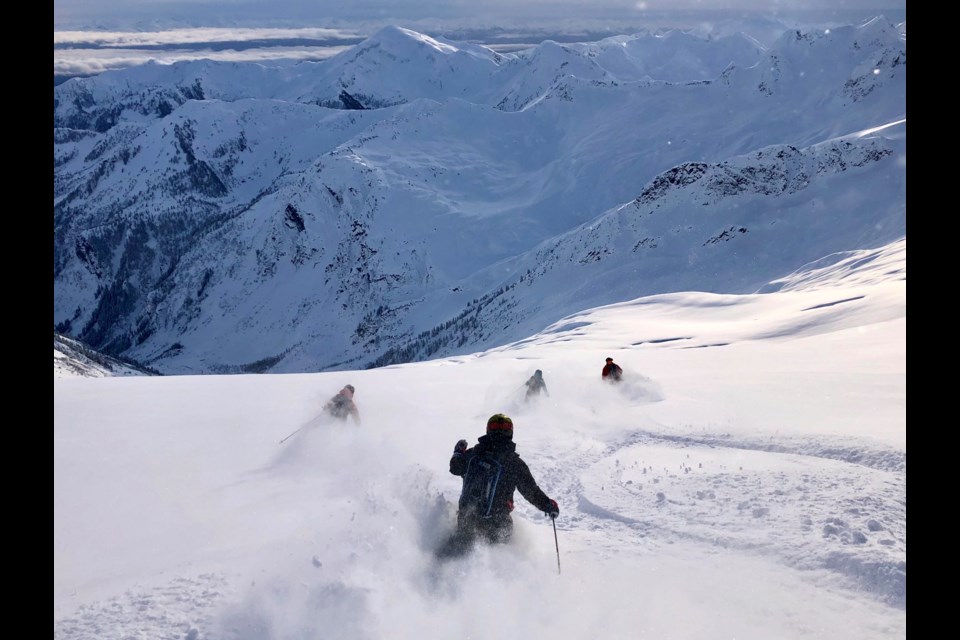While the South Coast is drowning in yet another atmospheric river (I’ve counted four since September and now this one), other parts of the province have been luxuriating in exceptional early season conditions of deep pow, where touring and turning have been on the menu since before Thanksgiving. One of those places is Shames Mountain outside Terrace. Seeing the Instagram gold from this ski Shangri La makes me think of my last trip there a couple of seasons ago.
On a stormy late-December day, my photographer friend Mattias Fredriksson and I skated off the Shames T-bar into the kind of fat-flakes ski dreams are made of. If we went left we’d drop through out-of-bounds glades, part of what’s been called the best slackcountry in all of North America. But with the sky too heavy to see much we opted to go right, choosing a thigh-deep plunge down one of Shames’ infamous double-blacks—mechanical bulls of stumps and rock that need at least a two-metre base to be skiable. On a day that snowy, however, it felt more like swimming with dolphins as we plunged in and out of the depths, gulping air at every turn.
After a few runs, we still hadn’t competed for lines or face shots with anyone, and, as the clouds lifted to reveal a Himalayan vista of glacial cirques and mountains limned by deep-cut valleys, superlatives flowed from my mouth while Mattias, a local, seemed nonplussed. Days this deep and uncrowded might be joyously commonplace for those who live here, but they demand to be shouted from the rooftops by visitors like me.
A unique, snow-choked ski area averaging 12 metres annually, Shames isn’t owned by some far-off corporation or conglomerate. Instead, it has operated since 2013 as Canada’s only non-profit community service ski co-operative. A picture of grassroots ski culture painted by legendary characters who could provide a cartoonist with fodder for a lifetime, the cadre of back-slapping skiers exchanging information and looking out for each other over a plate of poutine inside the homey base lodge that day reflected a community ethos of affordability, sustainability, collaboration, and innovation. All on a mountain range of such generous proportions that even if everyone in town were here it would have been hard to find them.
If space is the final frontier in skiing, Shames is its own planet.
As you might suspect, the co-op is the latest chapter in a long story of keeping skiing alive in a boom-and-bust resource town. When the lower elevations of the town’s original ski hill, Kitsumkalum, fell victim to a changing climate in the late 1980s, its infrastructure was uprooted and moved to Shames Mountain, located 35 kilometres west of Terrace with, as the Master Plan put it, a more “favourable” base elevation. Favourable indeed: the new hill’s inaugural opening in December 1990 was delayed after the groomer buried itself in four metres of new snow. That season, the area received a shocking 24 metres of the white stuff.
Snow has never been a problem at Shames, but isolation (a 15-hour drive from Vancouver) and low skier numbers have both blessed and cursed it from day one. Eventually the financial end of that equation caught up with the original owners and a local group was formed to buy the mountain and operate it as a co-op. The mountain still averages only 340 skiers each of the five days a week that it’s open and seldom exceeds 600, many of them only using the lifts to access surrounding plateaus and ridges that deliver 26 separate backcountry itineraries. Moreover, the ski area itself has embraced the backcountry experience, offering avalanche courses, selling maps and single-run lift tickets, providing rentals, and working hard to ensure skiers educate themselves with a beacon check-gate and hazard signage.
The curtain would rise on Shames’ enormous backcountry options the next day, but for the rest of that afternoon Mattias and I, along with our significant others, were content to drop through out-of-bounds glades onto a cat road that wrapped us right back to the base of the T-bar for another round, punctuating the cycle with a few runs on the main pistes that were now buried in 60-plus centimetres of snow and seemingly refilled on every round. I remember thinking that I could get used to the pace and punch of this kind of place, where bare bones skiing is all that matters.
Alongside the allure of Shames, Northern Escape Heli Skiing, Skeena Cat Skiing and Hankin-Evelyn Backcountry Recreation Area are drawing more skiers to the Highway 16 region often referred to as “Northern B.C.,” but which is really just the middle of our vast province. To meet demand for its backcountry bounty from locals and visitors alike, change is coming to Shames—but not in the form of restaurants, hotels or shopping (though you’ll still have to pay for WiFi in the lodge—the Lunch Hour Special is 250 MB for $2.95 CAD). The change that is coming is the only kind that matters: more skiing, as Shames cuts a series of unique 600-vertical-metre slackcountry runs on a frontside wooded ridge.
It basically adds up to another set of dreams for a stormy day.
Leslie Anthony is a Whistler-based author, editor, biologist and bon vivant who has never met a mountain he didn’t like.





